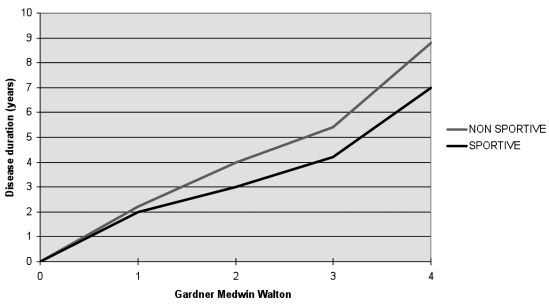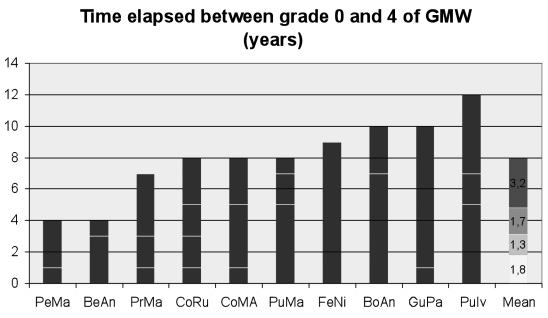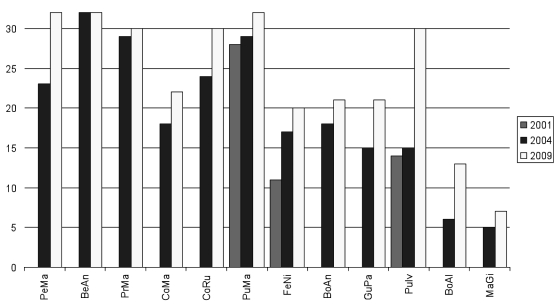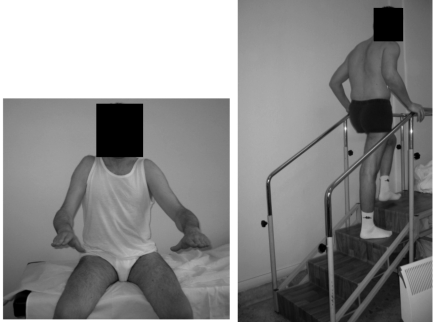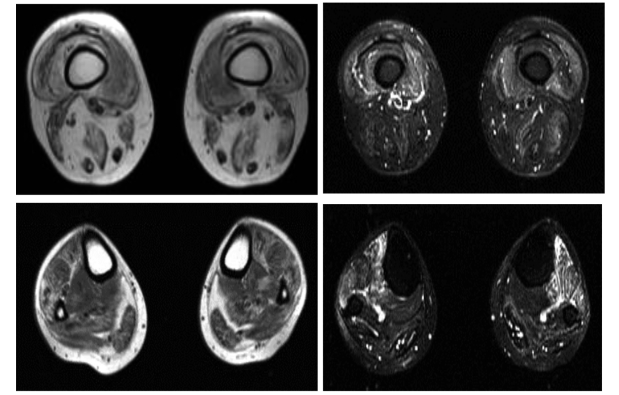Abstract
LGMD2B is a frequent proximo-distal myopathy with rapid evolution after age 20. Exacerbating factors may be physical exercise and inflammation. There is very little information about the effect of sportive activity in LGMD2B, since eccentric exercise frequently results in muscle damage. LGMD2B has often an onset with myalgia and MRI imaging (STIR-sequences) shows myoedema. In a prolonged observational study of a series of 18 MM/LGMD2B patients we have studied the pattern of clinical and radiological evolution. The disease has an abrupt onset in the second decade and most patients perform sports before definite disease onset. On the basis of Gardner-Medwin and Walton scale, grade 4 is reached two years faster in patients who performed sports (over 1000 hours). Other considerations regarding pathogenetic mechanism and response to treatment show a poor response to immunosuppressive treatment of muscle inflammation. Preventing a strenuous physical activity should be recommended in patients with high CK and diagnosed or suspected to have dysferlin deficiency.
Key words: dysferlin, pathogenesis, physical exercise, sport activity
Introduction
Dysferlinopathy represents a peculiar limb-girdle muscular dystrophy, with a particular challenge for the partially unsolved pathogenesis. The recognition of the two main phenotypes of distal Miyoshi Myopathy (MM) and proximal LGMD2B (1-5) were done early; most descriptions dealt with inbred populations or families with a limited number of mutations. Subsequent studies have reported larger numbers of patients with sporadic mutations and extended the clinical spectrum, to include onset in early childhood or adult age. In a large group of patients, in whom a clear distinction in their pattern of muscle involvement into Miyoshi or LGMD was not possible, an involvement of both the proximal and distal musculature was observed in most patients, especially as the disease progresses (6-8). The frequency of dysferlinopathy provides a further challenge. Dysferlinopathy appears to be a relatively common cause of LGMD in Southern European populations. Founder mutations exist in only a few small communities (6, 9, 10). Dysferlinopathy can be diagnosed mainly by Western blotting and, in fact, although the clinical diagnostic process by which dysferlinopathy is diagnosed is variable, most laboratories still rely on the diagnosis by muscle immunoblotting as the most reliable method, versus immunohistochemistry (11-13). Some laboratories carry out protein testing on monocytes as an alternative screening methodology (14). The gold standard for dysferlinopathy diagnosis is however DNA testing, with sequencing carried out in a small number of laboratories in Europe and the USA (7, 17).
A limitation of all LGMD2B studies however is that, with few exceptions, long-term follow-up data are not presented and data on clinical progression are collected in different ways, making precise comparisons between their conclusions difficult. Klinge et al. (5, 8) have observed that a unique finding within the spectrum of muscular dystrophies is that the majority of patients with dysferlin deficiency appear to have good muscle strength before onset of symptoms, leading to good performance at sports or to the ability to cope well with physically demanding activities; 53% of the patients were very active in sports before onset of clinical symptoms,which makes the clinical course of dysferlinopathy unusual and provides a challenge to understanding the underlying pathogenesis in this disease.
Material and methods
Natural history
Recently, two studies have addressed more systematically the topic of the natural history of dysferlinopathy. A study of 9 genetically confirmed LGMD2B and MM patients studied over 18 months, demonstrated a significant decline in muscle strength in a set of muscle groups measured by manual muscle testing, and in knee flexion measured by quantitative muscle testing, accompanied by a detectable deterioration on MRI in biceps femoris and tibialis posterior (15).
It is likely that in dysferlinopathy there are changes detectable with time that could address the design of future clinical trials, but the optimal measurements have yet to be defined representing the entire clinical spectrum of this diverse disease group.
Aims of the study
The primary aims of this study are the following:
To describe a cohort of patients with dysferlinopathy in terms of clinical, functional, strength and quality of life assessments, as well as for MRI results, and to explore associations between these assessments and gender, age, clinical distribution of muscle involvement/ mode of presentation, physical activity (in sports) versus non active prior to onset (cut-off 1000 hours) relationship of onset and deterioration.
-
To describe changes over time in these parameters over a eight year period and define the outcome measures capable of capturing this information most reliably.
Additional aims are:
To define the natural history of dysferlinopathy in an unselected patient group with respect to age and type of onset, and progression.
To study a selection of possible outcome measures for dysferlinopathy trials over a eight year period of 18 patients followed in our centre of excellence for muscular dystrophy diagnosis and management.
Patient questionnaire
As part of the natural course study, we collected directly from the patients the information about their disease onset and progression. This part of the study was done using a questionnaire by direct interview during the hospitalization or outpatient examinations and basic natural history data were obtained on a group of patients. Briefly, patients were informed about the more intensive clinically based protocol during an examination and given details to obtain genetic information, as well as of diagnosis. There was a cross-linking between the patient reported information and the clinician and physiotherapist- reported data collected at clinical reviews.
Clinical study of outcome measures and MRI
The data reported by the patients do not provide sufficient detail to exactly determine the performance of specific outcome measures in this group. For this purpose, our group of clinical evaluators worked on a set of evaluations (GSGCA scale) over a eight year time period, evaluating a group of 18 patients with proved dysferlinopathy by western blotting and mutation analysis (16, 17), representing the full spectrum of disease.
The diagnostic and neuromuscular protocol define inclusion and exclusion criteria for entry into the study (Table 1), collects baseline and follow-up data on investigations, including muscle biopsy, onset and its relation to sporting prowess, number of hours performed in various sporting activities, gender, clinical status, associated symptoms and levels of disability. Cardiac involvement was assessed by echocardiography and electrocardiography at the beginning and during the follow-up of the study.
Table 1.
| A. Inclusion criteria |
| Confirmed diagnosis of dysferlinopathy proven by a) two mutant alleles in the dysferlin gene (either homozygous mutation or compound heterozygous mutations) or b) one mutant allele and absent/severely reduced dysferlin amount on muscle immunoblot. Mutations were checked for their pathogenicity (16, 17). |
| Ambulant patients with or without aids were included; if a full-time wheelchair user only a certain number (1/4 of total number) of tests were done. |
| Ability to perform assessments (there are different assessments for ambulant and non-ambulant patients). |
| Informed consent to participate in the study. |
| Known current or planned medical or other interventions that might interfere with the possibility to undertake the planned tests. |
| Other concomitant pathology that in the view of the investigator would jeopardise the ability to take part in the protocol. |
| B. Exclusion criteria |
| Non ambulant patients |
| Patients who could not come for clinical examination |
The physical exams documented muscle strength, motor function and pulmonary function in ambulant and non-ambulant patients with the generally slowly progressive muscle weakness, taking into account the variable presentation in this condition. Clinical examination was done every year or less.
Protocol
At each bi-annual examination we performed:
General clinical questionnaire to include also sporting activity
Update on motor functions and other medical questions
Update on current medication
General physical examination
Cardiological exams
Respiratory exams
General neurological exam including muscle assessment
-
GSGCA assessment
-
Manual Muscle Testing (MRC scale) on the following muscle groups:
Hip flexors
Hip extensors
Hip abductors
Hip adductors
Knee flexors
Knee extensors
Ankle dorsiflexors
Ankle plantar flexors
Neck flexors
Neck extensors
Shoulder abductors
Shoulder flexors
Biceps brachii
Brachioradialis
Elbow extensors
Wrist extensors
Wrist flexors
Grip
Finger flexors
-
Timed Tests:
G = 10 m walk
S = Timed climb 4 stairs
G = to raise from floor (Gowers)
C = Timed to raise from Chair
A = arms manoeuvre
GSGCA functional scale score ranges from 4 to 35 grades.
Modified Gardner-Medwin and Walton scale
-
The clinical course of both diseases has been evaluated with 9 grades of the modified Gardner- Medwin- Walton as previously described (18): grade 0 = hyperCKemia, all activities normal; grade 1 = normal gait, unable to run freely, myalgia; grade 2 = incapacity to walk on tiptoes, waddling gait; grade 3 = evident muscular weakness, steppage and climbing stairs with banister; grade 4 = difficulty to rise from the floor, Gowers' sign; grade 5 = incapacity to rise from the floor; grade 6 = incapacity to climb stairs; grade 7 = incapacity to rise, from a chair; grade 8 = unable to walk unassisted; grade 9 = unable to eat, drink or sit without assistance.
CT and MRI procedures
In the case of dysferlinopathies, MRI studies have led to the observation that the muscles affected earlier are Gastrocnemius Medialis in the leg or Adductor Magnus in thigh. Furthermore, muscle involvement can be detected as a hyper-intensity on STIR sequences before it is clinically evident (18, 19). The muscles affected later are Vastus Lateralis and Soleus, and in the final stages of the disease, muscle wasting is diffuse, with a relative preservation of the Biceps Femoris and the Deep Flexors of the leg.
This particular pattern can be used to distinguish dysferlinopathies from other dystrophies and myopathies. A more precise analysis of the natural history of this disease will create a sound base on which to make a clinical prognosis.
The aim of this study was to better determine which muscles are involved in dysferlinopathies and to define the rate of progression of the disease. We evaluated the value of MRI as a surrogate marker of progression of the disease.
Muscle CT scan of the whole body was also used. We assessed the degree of impairment of each muscle and the extent of involvement of the different muscles in the disease and tried to establish the rate of progression (Fig. 1).
Figure 1.
Derived evolution of several muscle compartment in 14 LGMD2B/Miyoshi patients studied by CT scan. First distal posterior leg muscles show dystrophic changes (A), then posterior thigh muscles (B), subsequently anterior leg muscle (C) and finally upper limb muscles (D).
Statistical analysis
A population of 18 patients is large enough to accomplish our aim and to detect a difference of approximately 0.5 SD in any parameter of muscle strength between groups that have a ratio of 2:1 with 80% power while controlling for a Type I error of 0.05. Correlations as modest as 0.30 can be detected with approximately 90% power.
Results
The finding of sportive activity as an adverse event to dysferlinopathy course appears of interest: sport in effect is associated with eccentric muscle exercise and might deliver cytokines in muscle. This in turn might determine local inflammation and myoedema on MRI that often contributes and exacerbate disease course.
We examined 18 patients (14 males and 4 females, 3 pairs of brothers including 1 pairs of siblings). Two patients had consanguineous parents. The mean age was 33 years, ranging from 16 to 50 years. At the time of this clinical-radiological study, 13 patients had MM phenotype, 3 patients had classical LGMD phenotype and 2 patients had only hyperCKemia. The GSGCA functional scale showed the following data: 2 patients (12%) were asymptomatic with only hyperCKemia, 5 patients (28%) had difficulty in rising from the floor, 5 patients (28%) were unable to rise from the floor, 3 patients (17%) were unable in rising from a chair and 3 patients (17%) were not able to walk without assistance (18).
The further evolution of GSGCA score was variable in different patients. While the score increased rapidly in ambulant patients (Figs. 2, 3) it was much less progressive in non-ambulant patients (Figs. 4, 5).
Figure 2.
Two-year difference in time to reach grade 4 in 7 sportive versus 5 non-sportive LGMD2B patients. Cutoff time was put at 1000 hours of different sports (swimming, body building, soccer, cyclette, mountain bike, jogging, karate, basket, volley, dancing, gym, ski, hip-hop dancing) or outside working physical activity. A worsening in motor function was seen in sportive patients before disease onset.
Figure 3.
Time in years (mean = 8 years) to reach grade 4 of GMW scale in 10 LGMD2B patients.
Figure 4.
Evolution of GSGCA scale in a period of 8 years (from 2001 to 2009) in 12 LGMD2B patients. There is a worsening of functional grade performances that occurs at different times. The values of grades over 25 already express a severe involvement and therefore a further functional worsening is unlikely.
Figure 5.
Last clinical examination in two affected brothers: inability to lift arms (left-hand panel) and difficulty climbing stairs (right-hand panel).
We evaluated 17 patients by MRI imaging (T1, T2, STIR sequences). There was an inverse linear correlation between Mercuri (T1) score and muscle strength (MRC scale): Pearson Index (r) = -0.84; p < 0.001. There was a direct linear correlation between Mercuri (T1) score and disability score (GSGCA disability scale): Pearson Index (r) = 0.95; p < 0.005.
The distribution of fibro-fatty replacement in lower limbs was, also, investigated: in 15 patients (88%) the posterior compartment of the thigh and of the leg was more involved than the anterior; the mean fibro-fatty replacement grade in the posterior compartment of thigh and leg (% respect to the entire posterior compartment of the thigh and leg) was 72.6% and 72.9%, respectively (Fig. 6). STIR sequences analysis reveals a hyper-intense signal (myoedema), also in these patients. The quantification of this inflammatory aspect (Myoedema score) reveals a particular distribution: in 14 patients (82%) the anterior compartment of the thigh and leg is more involved than the posterior. The mean myoedema grade in the anterior compartment of thigh and leg (% respect to the entire anterior compartment of thigh and leg) is, respectively, 29.6% and 41.8% (Fig. 6).
Figure 6.
Fibro-fatty replacement (left-hand panel, T1 sequence) and myoedema (right-hand panel, STIR sequence) on muscle MRI.
Disease progression and clinical phenotype was also previously described (20).
No patients had cardiac involvement, but in few cases there was a moderate respiratory insufficiency.
In all cases CK levels were highly elevated (over 1000 U/L).
Discussion
The definition of a particularly good level of sporting prowess before the onset of symptoms and the description of a subacute onset with muscle pain and swelling, if better understood, could potentially help in our understanding of the pathogenesis of the disease. In a group of unselected patients we have tested the hypothesis whether such sportive activity might influence disease course and progression.
Direct clinical comparison with different forms of muscular dystrophy is difficult, since there is no direct match in age of onset and progression. However, when we compared clinical progression of LGMD2B with LGMD2A, the majority of LGMD2A (20) did not perform sportive activities, they are not so good at sports or avoided sports at all before disease onset, and LGMD2A seems to have an indolent atrophic course.
Immunosuppressive treatment has been variably tried in LGMD and also in dysferlinopathy patients. While other types of LGMD (LGMD2D, or LGMD2I) have variably responded to steroids, most reports on dysferlin deficiency on steroids are negative and dysferlin deficiency behaves as a refractory disease. In cases of uncertain diagnosis both immunohistological features and western blotting might help for an accurate diagnosis (17, 21, 22).
Also in view of inflammatory cell in the muscle, the administration of rituximab has been tried: two patients (23) had some improvement in muscle strength, especially in the isometric hand-grip contraction. To our knowledge, these are the only two cases with increased muscle grip but the report is anedoctical and an opentrial. Furthermore, one of the two patients did not report any sustained benefit.
IVIg has also been tried with variable efficacy. In our experience, there might be some amelioration due to possible down-regulation of the complement inhibitory factor CD55 but a real controlled trial has not yet been done.
Walker and a group of centers in Germany (data presented in Muscular Dystrophy Research Symposium, 2010, Padova) assessed the natural course of disease and efficacy of deflazacort treatment in 25 patients (between 25 and 63 years of age) with genetically confirmed dysferlinopathy in a double-blind, cross-over trial. During the first year of the study, they assessed the natural course of disease in 6-month intervals, evaluating MRC scores, quantitative strength measurement by hand-held dynamometry, and torque measurement, Neuromuscular Symptoms Score, Timed Function Tests (getting up from lying and sitting position, climbing 4 stairs, running 10m), Vignos Scale, Hammersmith Motor Ability Score, and Global Assessment CGI Scale, quality of life SF-36 scale and laboratory parameters (sodium, potassium, creatinine, urea, GOT, GPT, gamma-GT, CK, blood count, ESR, CRP). Medication (placebo or deflazacort in a cross-over design) was only started in the second year of the study. All patients showed a decline in muscle strength over one year, which was reflected in the tests performed.
All studies agree that dysferlinopathy is a chronically progressive condition, sometimes with periods where there is a plateau of muscle function, reaching at variable age wheelchair dependency.
References
- 1.Ueyama H, Kumamoto T, Nagao S, et al. A new dysferlin gene mutation in two Japanese families with limb-girdle muscular dystrophy 2B and Miyoshi myopathy. Neuromusc Disord. 2001;11:139–145. doi: 10.1016/s0960-8966(00)00168-1. [DOI] [PubMed] [Google Scholar]
- 2.Weiler T, Bashir R, Anderson L, et al. Identical mutation in patients with limb girdle muscular dystrophy type 2B or Miyoshi myopathy suggests a role for modifier gene(s) Hum Mol Genet. 1999;8:871–877. doi: 10.1093/hmg/8.5.871. [DOI] [PubMed] [Google Scholar]
- 3.Illarioshkin SN, Ivanova-Smolenskaya IA, Greenberg CR, et al. Identical dysferlin mutation in limb-girdle muscular dystrophy type 2B and distal myopathy. Neurology. 2000;55:1931–1933. doi: 10.1212/wnl.55.12.1931. [DOI] [PubMed] [Google Scholar]
- 4.Mahjneh I, Marconi G, Bushby K, et al. Dysferlinopathy (LGMD2B): a 23-year follow-up study of 10 patients homozygous for the same frameshifting dysferlin mutations. Neuromusc Disord. 2001;11:20–26. doi: 10.1016/s0960-8966(00)00157-7. [DOI] [PubMed] [Google Scholar]
- 5.Klinge L, Aboumousa A, Eagle M, et al. New aspects on patients affected by dysferlin deficient muscular dystrophy. J Neurol Neurosurg Psychiat. 2010;81:946–953. doi: 10.1136/jnnp.2009.178038. [DOI] [PMC free article] [PubMed] [Google Scholar]
- 6.Argov Z, Sadeh M, Mazor K, et al. Muscular dystrophy due to dysferlin deficiency in Libyan Jews. Clinical and genetic features. Brain. 2000;123:1229–1237. doi: 10.1093/brain/123.6.1229. [DOI] [PubMed] [Google Scholar]
- 7.Nguyen K, Bassez G, Krahn M, et al. Phenotypic study in 40 patients with dysferlin gene mutations: high frequency of atypical phenotypes. Arch Neurol. 2007;64:1176–1182. doi: 10.1001/archneur.64.8.1176. [DOI] [PubMed] [Google Scholar]
- 8.Klinge L, Dean AF, Kress W, et al. Late onset in dysferlinopathy widens the clinical spectrum. Neuromusc Disord. 2008;18:288–290. doi: 10.1016/j.nmd.2008.01.004. [DOI] [PubMed] [Google Scholar]
- 9.Leshinsky-Silver E, Argov Z, Rozenboim L, et al. Dysferlinopathy in the Jews of the Caucasus: a frequent mutation in the dysferlin gene. Neuromusc Disord. 2007;17:950–954. doi: 10.1016/j.nmd.2007.07.010. [DOI] [PubMed] [Google Scholar]
- 10.Weiler T, Greenberg CR, Nylen E, et al. Limb-girdle muscular dystrophy and Miyoshi myopathy in an aboriginal Canadian kindred map to LGMD2B and segregate with the same haplotype. Am J Hum Genet. 1996;59:872–888. [PMC free article] [PubMed] [Google Scholar]
- 11.Fanin M, Pegoraro E, Matsuda-Asada C, et al. Calpain-3 and dysferlin protein screening in patients with limb-girdle dystrophy and myopathy. Neurology. 2001;56:660–665. doi: 10.1212/wnl.56.5.660. [DOI] [PubMed] [Google Scholar]
- 12.Anderson LV, Davison K. Multiplex Western blotting system for the analysis of muscular dystrophy proteins. Am J Pathol. 1999;154:1017–1022. doi: 10.1016/S0002-9440(10)65354-0. [DOI] [PMC free article] [PubMed] [Google Scholar]
- 13.Vainzof M, Anderson LV, McNally EM, et al. Dysferlin protein analysis in limb-girdle muscular dystrophies. J Mol Neurosci. 2001;17:71–80. doi: 10.1385/JMN:17:1:71. [DOI] [PubMed] [Google Scholar]
- 14.Ho M, Gallardo E, McKenna-Yasek D, et al. A novel, blood-based diagnostic assay for limb girdle muscular dystrophy 2B and Miyoshi myopathy. Ann Neurol. 2002;51:129–133. doi: 10.1002/ana.10080. [DOI] [PubMed] [Google Scholar]
- 15.Paradas C, Llauger J, Diaz-Manera J, et al. Redefining dysferlinopathy phenotypes based on clinical findings and muscle imaging studies. Neurology. 2010;75:316–323. doi: 10.1212/WNL.0b013e3181ea1564. [DOI] [PubMed] [Google Scholar]
- 16.Kawabe K, Goto K, Nishino I, et al. Dysferlin mutation analysis in a group of Italian patients with limb-girdle muscular dystrophy and Miyoshi myopathy. Eur J Neurol. 2004;11:657–661. doi: 10.1111/j.1468-1331.2004.00755.x. [DOI] [PubMed] [Google Scholar]
- 17.Cacciottolo M, Numitone G, Aurino S, et al. Muscular dystrophy with marked Dysferlin deficiency is consistently caused by primary dysferlin gene mutations. Eur J Hum Genet. 2011;19:974–980. doi: 10.1038/ejhg.2011.70. [DOI] [PMC free article] [PubMed] [Google Scholar]
- 18.Borsato C, Padoan R, Stramare R, et al. Limb-girdle muscular dystrophies type 2A and 2B: clinical and radiological aspects. Basic Appl Myol. 2006;16:17–25. [Google Scholar]
- 19.Stramare R, Beltrame V, Dal Borgo R, et al. MRI in the assessment of muscular pathology: a comparison between limb-girdle muscular dystrophies, hyaline body myopathies and myotonic dystrophies. Radiol Med. 2010;115:585–599. doi: 10.1007/s11547-010-0531-2. [DOI] [PubMed] [Google Scholar]
- 20.Angelini C, Nardetto L, Borsato C, et al. The clinical course of calpainopathy (LGMD2A) and dysferlinopathy (LGMD2B) Neurol Res. 2010;32:41–46. doi: 10.1179/174313209X380847. [DOI] [PubMed] [Google Scholar]
- 21.Vinit J, Samson M, Gaultier JB, et al. Dysferlin deficiency treated like refractory polymyositis. Clin Rheumatol. 2010;29:103–106. doi: 10.1007/s10067-009-1273-1. [DOI] [PubMed] [Google Scholar]
- 22.Choi J, Park YE, Kim SI, et al. Differential immunohistological features of inflammatory myopathies and dysferlinopathy. J Korean Med Sci. 2009;24:1015–1023. doi: 10.3346/jkms.2009.24.6.1015. [DOI] [PMC free article] [PubMed] [Google Scholar]
- 23.Lerario A, Cogiamanian F, Marchesi C, et al. Effects of rituximab in two patients with dysferlin-deficient muscular dystrophy. BMC Musculoskelet Disord. 2010;11:157–163. doi: 10.1186/1471-2474-11-157. [DOI] [PMC free article] [PubMed] [Google Scholar]




